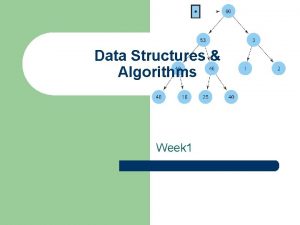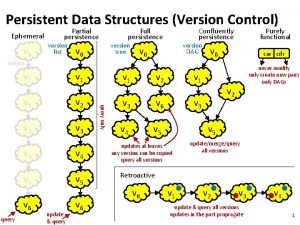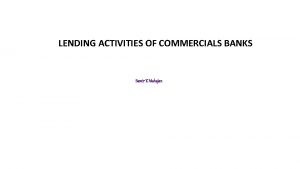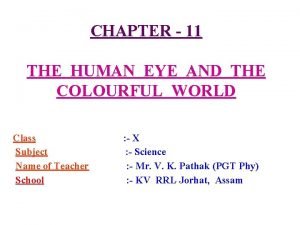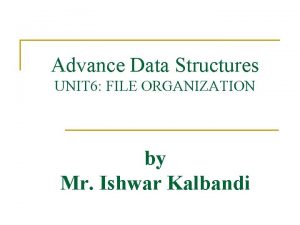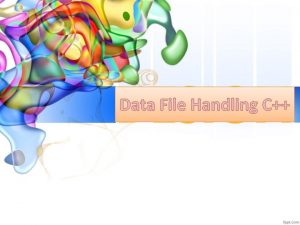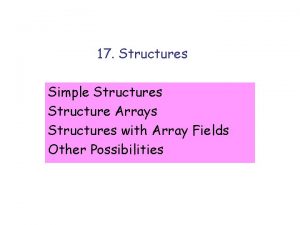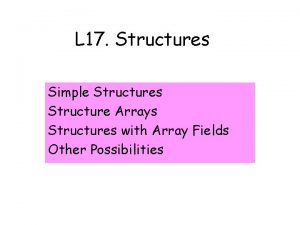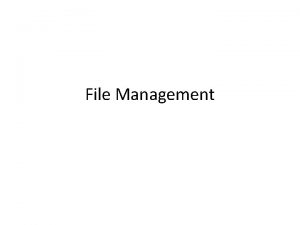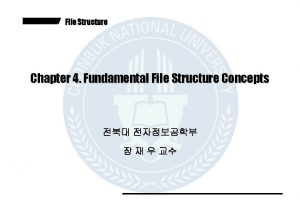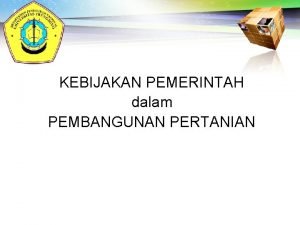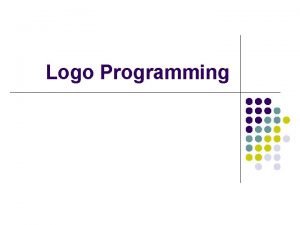LOGO Advance Data Structures FILE STRUCTURE AND FILE






























- Slides: 30

LOGO Advance Data Structures FILE STRUCTURE AND FILE ORGANIZATION BYProf. Abha Jain

wps. cn/moban Topics covered üWhat are files? üFile related keywords. üFile organization. 1. Introduction üFile organizing methods. 2. Strategy *heap file organization. *sequential files organization. 3. Challenges Forward *indexed file organization. *inverted file organization. 4. Conclusion *direct file organization. üComparison üQuiz

wps. cn/moban FILES A file is a collection of data that is treated as a single unit on a peripheral device. TYPES OF FILESMASTER FILE Ø It contains record of permanent data types. Ø They are created when you install your business. Work files a program can work efficiently if a work file is used. -a program can work efficiently if a work file is used.

wps. cn/moban FILES TRANSACTION FILE ØContains data which is used to update the records of master file. Ex-address of a customer. ØTransaction files also serves as audit trails and history of the organization.

BASIC FILE RELATED KEYWORKS • Byte: - It is the smallest addressable unit in computer. A byte is a set of 8 bits and represents a character. • Element: - It is a combination of one or more bytes. It is referred to as a field. A field is actually a physical space on tape or disk. A roll number, age, name of employee etc. are examples of it. File: - It is a collection of similar records. The records will have the same fields but different values in each record. The size of a file is limited by the size of memory available.

BASIC FILE RELATED KEYWORDS • Database: - It is a set of interrelated files. The files in combination tend to link to a common solution. For example, a student attendance file, a student result file, a student admission file, etc. are related to academic software pertaining to students. • Record: - The elements related to are combined into a record. An employee has a record with his name, designation, basic pay, allowances, deductions etc. as its fields. A record may have a unique key to identify a record e. g. employee number. Records are represented as logical & physical records. A logical record maintains a logical relationship among all the data items in the record. It is the way the program or user sees the data. In contrast a physical record is the way data are recorded on a storage medium.

FILE ORGANIZATION It is the methodology which is applied to structured computer files. Files contain computer records which can be documents or information which is stored in a certain way for later retrieval. File organization refers primarily to the logical arrangement of data in a file system. It should not be confused with the physical storage of the file in some types of storage media. There are certain basic types of computer file, which can include files stored as blocks of data and streams of data, where the information streams out of the file while it is being read until the end of the file is encountered.

Methods of organizing files Different methods of organizing files 1. Heap 2. Sequential 3. Indexed-sequential 4. Inverted list 5. Direct access

Choosing a file organization is a design decision, hence it must be done having in mind the achievement of good performance with respect to the most likely usage of the file. The criteria usually considered important are: 1. Fast access to single record or collection of related records. 2. Easy record adding/update/removal, without disrupting. 3. Storage efficiency. 4. Redundancy as a warranty against data corruption.

Heap files(unordered) Basically these files are unordered files. It is the simplest and most basic type. These files consist of randomly ordered records. The records will have no particular order. The operations we can perform on the records are insert, retrieve and delete. The features of the heap file or the pile file Organisation are: 1. New records can be inserted in any empty space that can accommodate them. 2. When old records are deleted, the occupied space becomes empty and available for any new insertion. 3. If updated records grow; they may need to be relocated (moved) to a new empty space. This needs to keep a list of empty space.

Advantages and disadvantages Advantages 1. This is a simple file Organisation method. 2. Insertion is somehow efficient. 3. Good for bulk-loading data into a table. 4. Best if file scans are common or insertions are frequent. Disadvantages 1. Retrieval requires a linear search and is inefficient. 2. Deletion can result in unused space/need for reorganisation.

Heap file organization In the below figure, we can see a sample of heap file organization for EMPLOYEE relation which consists of 8 records stored in 3 contiguous blocks, each blocks can contains at most 3 records.

Sequential file organization • Stored in key sequence. • Adding/deleting requires making new file. • Used as master file. • Records in these files can only be read or written sequentially.

Sequential file organization • Records are also in sequence within each block. To access a record, previous records within the block are scanned. Thus sequential record design is best suited for “get next” activities, reading one record after another without a search delay. • records can be added only at the end of the file.

Advantages and disadvantages ADVANTAGES ØSimple file design ØVery efficient when most of the records must be processed e. g. Payroll ØVery efficient if the data has a natural order ØCan be stored on inexpensive devices like magnetic tape. DISADVANTAGES ØEntire file must be processed even if a single record is to be searched. ØTransactions have to be sorted before processing ØOverall processing is slow.

Indexed-sequential organization ØEach record of a file has a key field which uniquely identifies that record. ØAn index consists of keys and addresses. ØAn indexed sequential file is a sequential file (i. e. sorted into order of a key field) which has an index. ØA full index to a file is one in which there is an entry for every record. ØWhen a record is inserted or deleted in a file the data can be added at any location in the data file. Each index must also be updated to reflect the change. For a simple sequential index this may mean rewriting the index for each insertion.

Indexed-sequential organization

Indexed-sequential organization



Indexed-sequential organization Indexed sequential files are important for applications where data needs to be accessed. . . Sequentially randomly using the index. An indexed sequential file can only be stored on a random access device e. g. magnetic disc, CD.

ADVANTAGES AND DISADVANTAGES Advantages ØProvides flexibility for users who need both type of accesses with the same file. ØFaster than sequential. Disadvantages ØExtra storage space for the index is required

Inverted list organization v. Like the indexed-sequential storage method, the inverted list organization maintains an index. The two methods differ, however, in the index level and record storage. The indexed- sequential method has a multiple index for a given key, whereas the inverted list method has a single index for each key type. v. The records are not necessarily stored in a sequence. They are placed in the are data storage area, but indexes are updated for the record keys and location.

ADVANTAGES AND DISADVANTAGES Advantages ØThe benefits are apparent immediately because searching is fast disadvantages Øinverted list files use more media space and the storage devices get full quickly with this type of organization. Øupdating is much slower.

Direct/random file organization ØRecords are read directly from or written on to the file. ØThe records are stored at known address. ØAddress is calculated by applying a mathematical function to the key field. ØA random file would have to be stored on a direct access backing storage medium e. g. magnetic disc, CD, DVD Example : Any information retrieval system. Eg Train timetable system.

Advantages and disadvantages Advantages ØAny record can be directly accessed. ØSpeed of record processing is very fast. ØUp-to-date file because of online updating. ØConcurrent processing is possible. Ø Transactions need not be sorted. Disadvantages ØMore complex than sequential. ØDoes not fully use memory locations. ØMore security and backup problems. Ø Expensive hardware and software required. Ø System design is complex and costly. Ø File updation is more difficult as compared to sequential files.

wps. cn/moban Comparison

Quiz 1. Different types of files are a)Master Transaction Backup b)Archive Table Report c)Dump Library 2. Major criteria for selecting a File organization are 1. Method of processing of file 2. Size of data 3. File inquiry capability 4. File volatility 5. Response time 6. Activity ratio

Quiz 3. What is file organization? 4. What are advantages of sequential file organization? 5. True or false (indexed sequential file) The data can be added at any location in the file. 6. Give an example of direct file organization? 7. Give one advantage and disadvantage of direct file organization?

Thank You
 File-file yang dibuat oleh user pada jenis file di linux
File-file yang dibuat oleh user pada jenis file di linux Data integrity in hadoop
Data integrity in hadoop Static and dynamic queue in data structure
Static and dynamic queue in data structure Analogous structures
Analogous structures Unix vtu notes
Unix vtu notes Difference between logical file and physical file
Difference between logical file and physical file Ajit diwan
Ajit diwan Kevin wayne princeton
Kevin wayne princeton Data structures and algorithms tutorial
Data structures and algorithms tutorial Data structures used in macro processor
Data structures used in macro processor Assembler data structures
Assembler data structures Information retrieval data structures and algorithms
Information retrieval data structures and algorithms Data structures and abstractions with java
Data structures and abstractions with java Data structures and algorithms bits pilani
Data structures and algorithms bits pilani Adts, data structures, and problem solving with c++
Adts, data structures, and problem solving with c++ Ajit diwan iit bombay
Ajit diwan iit bombay Data structures and algorithm
Data structures and algorithm Data structures and algorithms
Data structures and algorithms Data structures and algorithms
Data structures and algorithms Waterloo data structures and algorithms
Waterloo data structures and algorithms Signature file structure in information retrieval system
Signature file structure in information retrieval system Ephemeral data structure
Ephemeral data structure Data structures and algorithms
Data structures and algorithms Difference between loan and advance
Difference between loan and advance Cues, questions, and advance organizers
Cues, questions, and advance organizers Disadvantages of advance directives
Disadvantages of advance directives Advance sunrise and delayed sunset is due to
Advance sunrise and delayed sunset is due to Click roll and advance
Click roll and advance Marzanos 9
Marzanos 9 Cues questions and advance organizers
Cues questions and advance organizers Skimming advance organizer examples
Skimming advance organizer examples
















